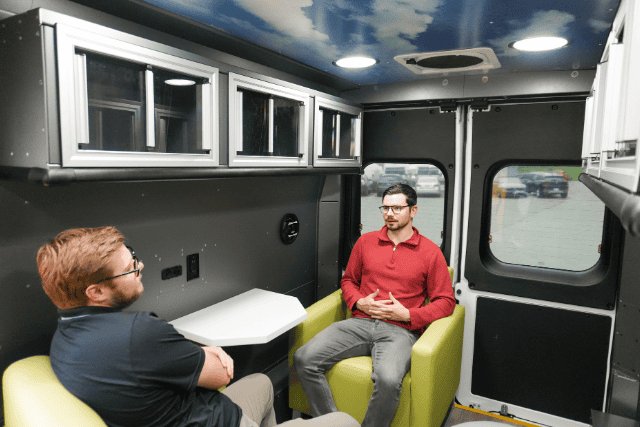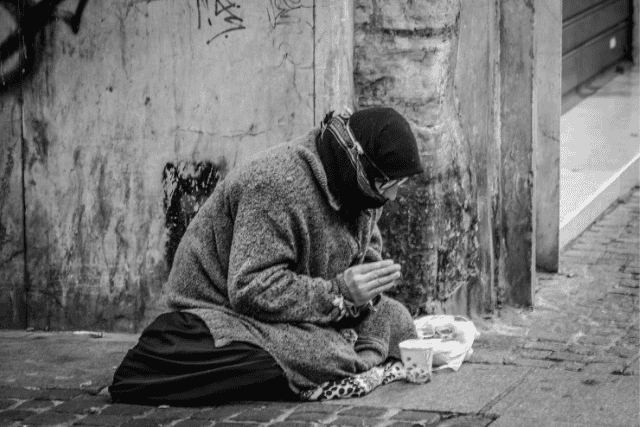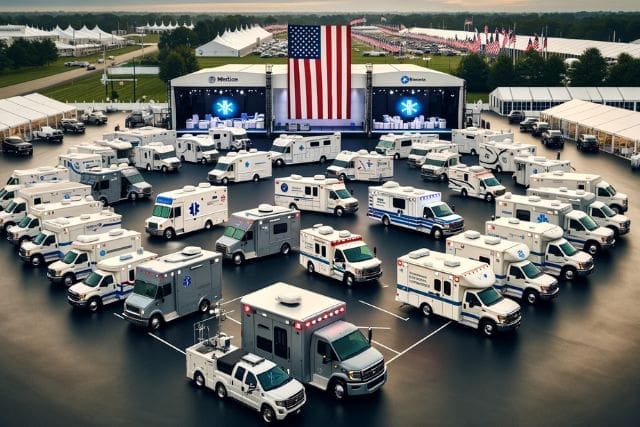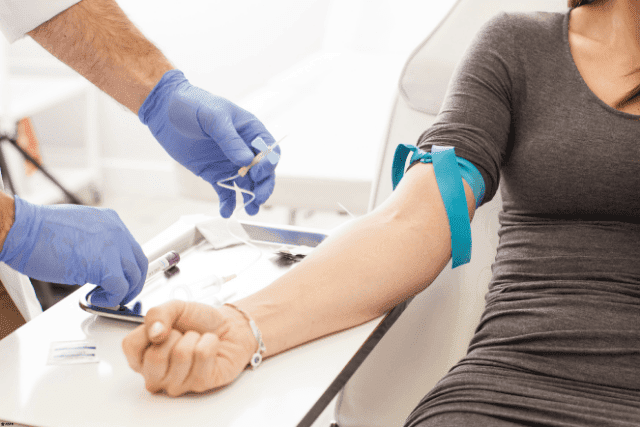Homelessness in Pennsylvania is rising fast, and is up over 12% in just the past year, according to recent reports. If you’re part of a non-profit, health clinic, or community service, you’re likely seeing this every day.
- People without shelter
- Families living in cars
- Veterans without a safe place to sleep
The challenge? Many homeless people in need can’t get to help. Shelters might be full. Clinics might be too far. Some folks don’t trust the system or have experienced trauma that keeps them away. Others just don’t have a way to travel.
This creates a huge gap. Services exist, but they’re out of reach. When help isn’t accessible and doesn’t come to them, people get stuck in survival mode. Health issues grow worse. Mental health goes untreated. And housing feels even further away.
But there is a way to meet people where they are.
At AVAN Mobility, we build vehicles like the Mobile Outreach Van and Mobile Counseling Van to bring care and support right to the streets, parks, and neighborhoods where people need it most. We work with organizations like yours and Siskiyou County across the U.S. to design units that actually work in the real world.
In this article, we’ll walk through:
- What’s happening with homelessness in Pennsylvania
- How mobile units can support outreach teams
6 things contributing to homelessness in Pennsylvania
Homelessness in Pennsylvania is growing, and it’s growing for a lot of reasons. More people are living without stable housing, from big cities like Philadelphia to smaller communities like Altoona. According to the U.S. Department of Housing and Urban Development, there were over 14,000 people experiencing homelessness in Pennsylvania in 2023. That number is rising every year.
So what’s causing it?
Housing costs are climbing
Finding an affordable place to live in Pennsylvania isn’t as easy as it used to be. In areas like Pittsburgh and the Lehigh Valley, rent prices have gone up, but incomes haven’t kept up. Folks working full-time jobs still can’t afford rent. And when someone loses their job or faces a health crisis, they may end up living in their car or on a friend’s couch. It doesn’t take much to fall behind.
Mental health and homelessness are deeply connected
One of the biggest causes of homelessness in Pennsylvania is untreated mental illness. Many people living on the streets struggle with depression, PTSD, schizophrenia, or anxiety. For some, mental health challenges make it hard to hold a job or keep up with rent. Others end up homeless after losing access to care or support systems.
Without access to care, the cycle continues:
- No home means less access to treatment
- No treatment means harder days, fewer options
- And without support, things spiral
Homeless shelters in Pennsylvania are overwhelmed
Across the state, homeless shelters in Pennsylvania are doing everything they can. But many are at full capacity. Others have strict rules or limited hours. That means people with untreated mental illness, addiction, or trauma may not feel safe going there. And when they do, there’s often a long wait just to be seen.
Discharge from hospitals, jails, or foster care
Some folks leave places like hospitals, prisons, or foster care without a solid plan for where to go next. This is a big reason why youth homelessness is rising in Pennsylvania. When young adults age out of care or are discharged without housing support, they’re left on their own.
Evictions and legal barriers
A past eviction record, poor credit, or even a criminal history can make it nearly impossible to get approved for housing, regardless of one’s efforts. Once a person loses housing, just having “nowhere to live” on a rental application becomes a red flag for landlords.
Substance use and lack of services in rural areas
Another major cause of homelessness here? Addiction.
Opioid use continues to rise across the state, especially in rural counties like Fayette, Cambria, and Schuylkill. But the services to help people? They’re not keeping up.
- Rehab programs have waitlists
- Mental health providers are spread thin in rural towns
- Some counties don’t have enough shelters at all
So, when someone is trying to recover but has nowhere safe to stay, they’re set up to fail. Addiction and homelessness go hand in hand, especially when there’s no support nearby. And let’s not forget, many people use substances just to cope with the stress and trauma of being homeless in the first place.
The result? A cycle that’s hard to break, especially when your team is working out of a central office miles away from where help is really needed.
That’s where mobile support comes in. In the next section, we’ll look at how your organization can use mobile units to bring care directly to people, wherever they are.
How can your organization help solve homelessness in Pennsylvania?
There’s no one-size-fits-all fix for homelessness in Pennsylvania. But the good news is that people and organizations across the state are working on it. Some focus on keeping people from losing their homes, while others help folks already living on the streets or in shelters.
1. Build more affordable housing
One of the biggest causes of homelessness, as we talked about earlier, is housing costs. Rent is going up, but incomes aren’t keeping up. That’s leaving many people just one paycheck away from losing their homes.
Here’s what’s working:
- Affordable housing programs like PHARE (Pennsylvania Housing Affordability and Rehabilitation Enhancement) help build or fix low-cost homes.
- Rental assistance helps families cover costs before they fall behind.
- Eviction prevention services step in before someone loses their home.
But there’s still a big gap:
- In 2023, for every 100 extremely low-income renters in PA, there were fewer than 40 affordable places to live.
- The shortage is even worse in smaller towns and rural areas.
Why does this matter?
When people have a safe place to live:
- They can look for work more efficiently
- They’re more likely to get help for health or mental health issues
- They can start planning long-term, not just surviving day by day
A stable home is the first step toward rebuilding a life.
2. Use the Mobile Outreach Van to help people where they are
A Mobile Outreach Van gives your team a clinic, office, and transportation solution in one vehicle. This matters in a state like Pennsylvania, where homeless shelters in Pennsylvania might be full or too far away for someone in need. When your services are easier to access, people are more likely to say yes to help.
Here’s how each feature can help your team make a real difference:
| Feature | How it helps fight homelessness in Pennsylvania |
| Sink and fridge | It allows you to offer water, basic hygiene, and safe food or medicine storage. This is huge for folks who don’t have access to clean water or meals. |
| Power supply | Keeps medical tools, phones, or tablets running all day so you can offer care and manage data anywhere. |
| Floor-to-ceiling storage | Plenty of room for warm clothing, hygiene kits, snacks, or first-aid supplies. |
| Mobile office desk space | Makes it easy to fill out forms, sign people up for housing programs, or connect them with social services. |
| Overhead storage | Tuck away extra supplies and keep your workspace neat and efficient. |
| Removable passenger seats | Create a flexible space for privacy during mental health chats or medical check-ups. |
| Rear heat and A/C | Stay warm in Erie or cool in Philly. Makes the van a safe space no matter the season. |
| Records/equipment storage | Keeps charts, laptops, or testing gear organized and secure. Helps with follow-ups, too. |
| Bright LED interior lights | Offers safe, clear visibility even in early mornings or late-night visits. |
| Customization options | Add winter tires for snowy backroads or tables for pop-up clinics. You can build what your team actually needs. |
3. Support mental health with a Mobile Counseling Van

Mental health issues and homelessness often go hand in hand. Some people become homeless because of untreated mental illness. Others develop mental health struggles after being on the street for too long.
Your organization can help stop this cycle. The Mobile Counseling Van gives your team a safe, private, and calming space to meet people where they are, whether in big cities like Pittsburgh or small towns across the state.
Here’s how each feature supports your mission to reduce homelessness in Pennsylvania:
| Feature | How it helps with homelessness in Pennsylvania |
| Comfortable living room furniture and feel | Makes the van feel more like a home, not a clinic. Helps people relax and open up during tough conversations. |
| Lockable cabinets | Keep sensitive items like paperwork, tablets, and medications safe and secure. |
| Speakers | Play calming music or wellness messages to help reduce stress and anxiety. Great for mental health check-ins. |
| Starlink Wi-Fi | Stay connected even in rural areas. Use telehealth tools, fill out housing forms, or check in with support teams. |
| Skylight | Natural light boosts mood and makes the space feel more welcoming, which is key when supporting vulnerable people. |
| Ramp for wheelchair access | Makes sure no one is left out. Everyone deserves access to care, including those with mobility needs. |
| Rear heat and A/C options | Keeps the space comfortable all year round. Whether it’s freezing in Scranton or humid in Harrisburg, your team stays ready. |
This van helps you offer real support, not just a quick fix. You can show up with a private, calm space for one-on-one conversations and early interventions.
And when you treat mental health early, you can help prevent someone from becoming homeless in the first place.
How can you take the next step and help end homelessness in Pennsylvania?
You’re here because you care. You’ve seen the numbers. You know the challenges. And now, you’ve learned about a few real ways your team can take action.
Whether you’re working in:
- A community health center
- A local shelter
- A non-profit or outreach program
- Or even a municipal service team
You don’t have to take on this crisis alone.
Here’s how you can start helping today:
- Look at what’s already working in your area. Can you partner with other teams to expand services?
- Identify the gaps. Is there a part of your city or county that’s underserved?
- Think mobile. From health services to mental health outreach, going mobile helps you meet people where they are.
- Talk to your team. What do they need most to do their jobs better?
Ending homelessness in Pennsylvania won’t happen overnight. But your organization can be part of the solution.
At AVAN Mobility, we design vehicles that deliver hope, dignity, and care right to the people who need it. With 10+ years of experience in building medical and outreach vans, we’ve supported dozens of organizations working on the frontlines. Every unit is made right here in North America and backed by a team that understands the day-to-day challenges you face.
If you have questions or want to explore options, click the button below to talk to a mobility expert who’s ready to help.
If you’re not ready to talk to a mobility expert yet, we have a few other resources you should check out to learn more:
Start by checking out our article to learn what street outreach is all about.
After that, read our article on mobile mental health to broaden your familiarity with it.




